Art Out of the Everyday
vol.3
Sculptures from Newspaper and Masking Tape
Sekiguchi Kotaro, Saitama Prefecture
2016.11.10
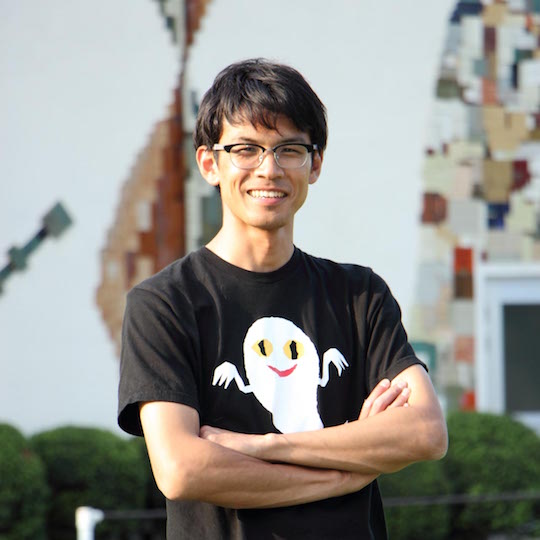
©You Sung Gil
An art school graduate, Sekiguchi Kotaro today teaches art at a special education school in the Tokyo area. For several years he has been spending his summer vacations and other holidays creating sculptures made with newspaper and masking tape. Art, he says, is a means for establishing connections with other people.
Having My Way with Newspaper and Masking Tape
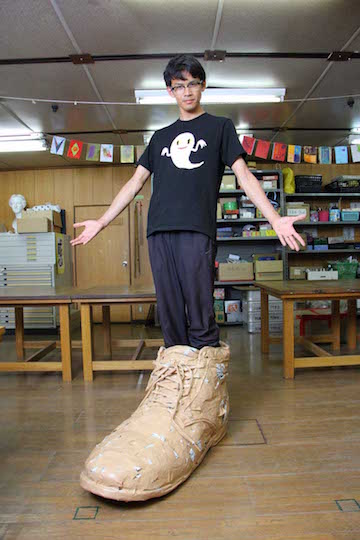
©You Sung Gil
At art school, I chiseled stone, carved wood, and studied about all the various materials and techniques in the classroom. If you want to work in stone or wood, you need big equipment and sometimes the materials are very large and heavy; moving them around is troublesome and can cost a lot of time and money.
But I always wanted to pursue art in a medium that wouldn't involve so much trouble or cost. Say you're walking along the street and you see a cat, and think you'd like to capture that cute animal in an art work. If the medium of your art work is stone, you really have a lot to think about.
Then I remembered a summer art project I did when I was in third grade--a three-dimensional work made out of newspaper and masking tape. With help from my mother, I made a statue of a stegosaurus, my favorite dinosaur. So in art school, apart from my regular assignments, I made a work depicting my favorite professional wrestler from those same materials. Imagining the way I wanted to shape the figure, I crumpled the paper, molded it, ripped and tore it, balled and bunched it up to form the figure, and then secured it all in place with masking tape. It actually came out quite well.
I made quite a few works from those materials while in art school, mostly without ever making even a sketch or drawing. If I'm making something just following a prearranged design, I end up finding it rather boring. Moving my hands and manipulating the paper and tape really gets my imagination going.
Big and Unanticipated Entertainment
For my graduation project at art school I made the newspaper and masking tape work "Shunkan Jiin" (Instant Temple). I wanted to make a work big enough to tower overhead. I got the idea from a monster movie I saw when I was a kid. It was that movie that inspired me to pursue a career as someone who makes things. Plus, I think making a work big is something that makes it entertaining. The Great Buddha of Nara--you know--is a huge attraction, just because it's so big. Everybody wants to go see it.
I decided not to paint on any colors but just leave it the beige color of the masking tape. From a distance, you can't really tell--it might be made of wood, or clay, or something else. I made it deliberately to kind of play tricks on the onlooker--you only find out that it's masking tape when you get close.
Since art is what you use to express your thoughts and ideas, showing your works is a chance to have onlookers unilaterally "hear" what you have to say. Then, since I think it's actually rather unfair to show art one-way like that, in exchange for having them "listen" to my form of expression, I try to make it as entertaining for them as possible.
With an introduction by my sculpture professor at art school, my graduation project piece was introduced with photographs in a magazine. I'm very grateful that my school let me submit that work for my graduation project, even though it didn't use any of the methods we'd been taught in class but was kind of an artistic detour I had taken.
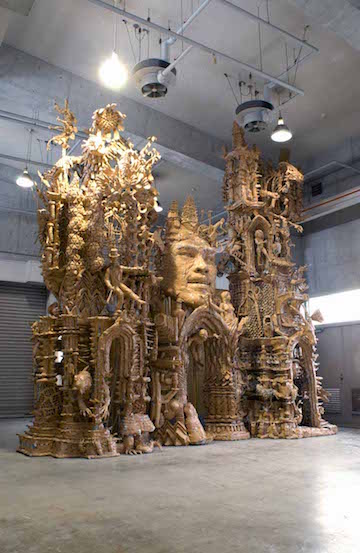
Photograph: 2006 Graduation Art Project, "Shunkan Jiin"
Big Break at the Miyake Issey Exhibition
When I graduated from art school, I actually thought I'd stop making art works. If Japan has 20 sculptors, I thought, it didn't need any more, and because I was unknown, no one was likely to come see my work. Also, art work wouldn't pay the bills and I wouldn't be able to survive or have a family.
So after graduation I took a job as an art teacher at a private school for children with special needs called Asahide Gakuen. I was glad to have stable work as a teacher and I gain satisfaction from being able to transmit what I know to the children who are my students.
Then about a month after I began teaching, I was standing in the rain at a train crossing when I got a phone call from someone who wanted to commission a work from me. It was the secretary to the famous designer Miyake Issey. Apparently Miyake had seen my graduation project in the magazine. I myself didn't have much interest in looking at the works of other people, so I actually didn't even know who Miyake Issey was! It was only when I told my family about the request and they got all excited that I learned how famous he is.
So after work I went to meet Mr, Miyake at the gallery in Roppongi where he was in the process of planning an exhibition. "Here," he said, "I'd like you to make a work in this space here." He was gesturing toward a really high, large atrium space.
I remember feeling ecstatic--I might be able to make the work I've always dreamed about! I had thought I had made the transition to being a teacher. I had been putting a firm lid on my urge to do creative work. But it was still going strong.
I had only just started teaching, however, and at first I thought I wouldn't be able to find enough time to make the requested work and thought of quitting teaching. When I talked about it with a friend, his said, "It would really go against common sense to quit a job you have only just begun, so you'd better just do your best and carry on with both." So that's what I did. I finished off the commissioned work during a break in the school year.
I really gain a lot from my teaching as well, so I'm very glad that I decided to keep my job as well as pursue my creative work. And ever since that time, I continue to teach at the school and use my summer and other holidays to make art works.
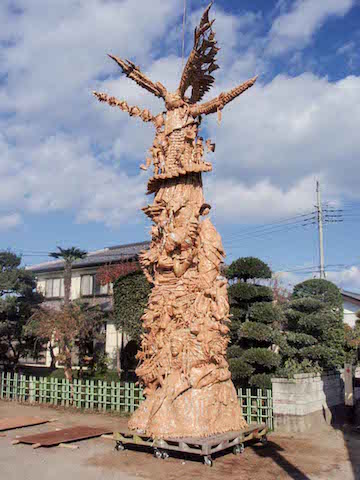
Photograph: "Akarui yoru ni shuppatsu da" (Departure on a Moonlight Night), created for "XXIc.21 Seikijin" (People of the 21st Century) exhibition at 21_21 DESIGN SIGHT, Tokyo 2008.
Committing to Continuing Artwork
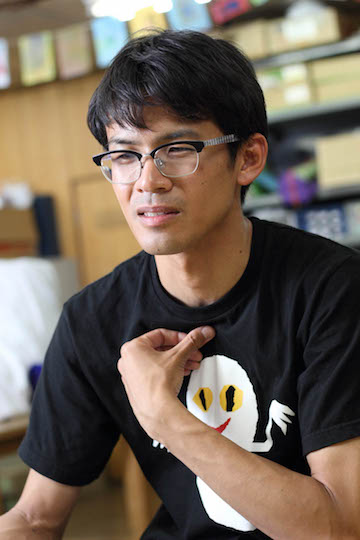
©You Sung Gil
After that exhibit, however, I didn't receive any more commissions for my works. My wife was also ill for a while and I hesitated to take as much time to spend with my artwork as before. After a while I began to grow unhappy and restless not being able to make anything. My wife could tell I needed an outlet for my creative impulse, and it was she who showed me the announcement inviting works for the Taro Okamoto Award for Contemporary Art, suggesting I try submitting something.
Well, soon after that the earthquake and tsunami disaster struck the Tōhoku region -that was March 2011. Tokyo really did not suffer directly from the disaster, but the windows at my school would often rattle when the aftershocks came. Over the Internet, I saw images of tidal wave smashing through houses, greenhouses, and fields. I thought art was not something as useful as houses and greenhouses, so I felt quite depressed and couldn't imagine spending time creating artworks when people were suffering from the disaster.
However, my job was to teach about art, and I realized that a person in my position should never shy away from new ways of expression or from artwork. So I pulled myself together, and as I began to look around for some material, a screw drew my attention. I suddenly realized that screws are used in just about every manmade thing there is; if you take a good look, you realize that screws are everywhere--they are practically symbols of the production of things.
So I set to work and made a sculpture of a screw using newspaper and masking tape. That was my declaration committing myself to being an artist. It was of course not a screw for practical use but in the sense that it was a screw meant to appeal to people's sensibilities, I named the work "Kansei neji" (The Sensibility Screw).
"Kansei neji" went on to win the Taro Award at the 15th Taro Okamoto Award for Contemporary Art. The night the award was announced, my wife made my favorite dish--hamburger steak--and I knew it was a happy day when she said she, too, had been energized by my success.
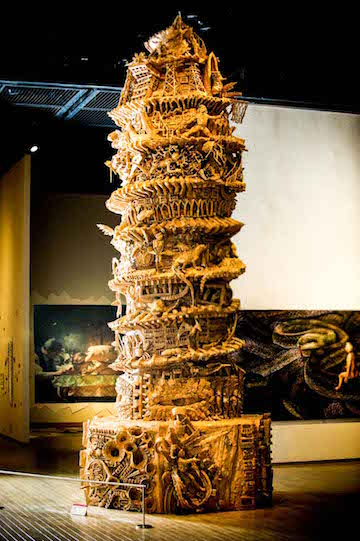
photograph: 15th Taro Okamoto Award for Contemporary Art Exhibition, Taro Award-winning work, "Kansei neji"
©Mori Hidetsugu
Sharing the Fun of Art by People with Disabilities
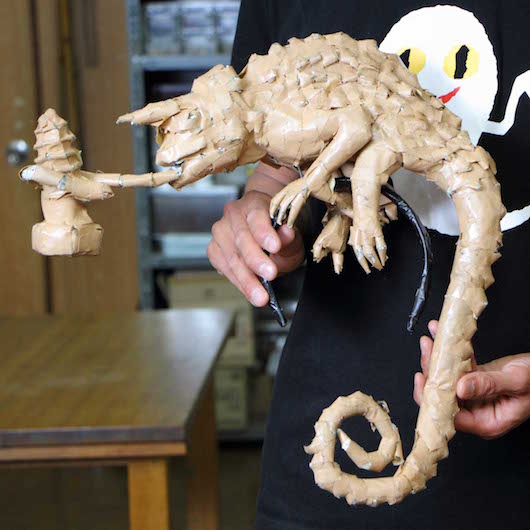
©You Sung Gil
I am always impressed by the great freedom of imagination and perspective of my students at Asahide Gakuen. For example, they were fascinated by the number "17" in pretty letters, teaching me that you can find beauty in the most unexpected places. When I saw that, I began incorporating numbers done in nice lettering into my own works.
In Japan, there is a tendency to introduce the art of people with disabilities as something that is supposed to make the people who see it feel deeply moved, sometimes to tears, but the works my students make are not like that; they are really quite funky. They make all kinds of things that make you burst out laughing. I would love to be able to share the delight of these works with more people.
Art Is a Means of Connecting with Other People
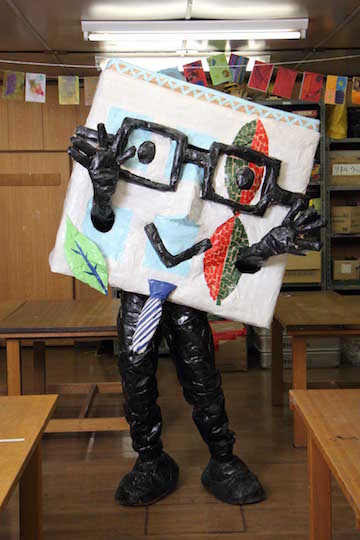
Asahide Gakuen's mascot character "Asahide Gakuen san."
©You Sung Gil
I have had the good fortune to meet all sorts of people, including all my students, because of art. I know that if you took art away from me, I would feel completely empty. And I would have few friends. I would like to tell everyone--my students, the art school students, and young people in general--that art is not just a way of expressing your own world--it is also a means for connecting to other people.
The students with disabilities I teach, in particular, could achieve much in transmitting their existence and what they have to offer through the world of art. Reading, writing, arithmetic, and sports may be difficult for them, but they can really hold their own when it comes to art.
What I want to try to do now is to plan exhibitions with my own and my students' works and also to plan an event for the Tokyo Olympics/Paralympics (2020) to which they can contribute. The Paralympics have events for people with disabilities but those with intellectual disabilities like my students can rarely participate, and there is no place for them to shine. I hope there will be a large cultural event at which they can display their artwork, giving them a sense of having participated in the Tokyo Olympic Games as well.
What with the problem of the Olympic emblem plagiarism incident and the troubles over the cost of the new National Stadium, the tendency in Japan that makes it difficult to do anything unprecedented or freewheeling in imagination remains quite strong. That's really too bad. You may not have much money, but you can make some pretty entertaining things with inexpensive materials like newspaper and masking tape. In that sense, now is perhaps a chance for people like me to make a statement. I'll keep on working on my pieces and writing in my blog about them and my students' work.
Interview: May 2016
Compilation: Yamagishi Hayase
Related link:
The Asahide Gakuen blog displays pictures of the mascot character designs and other works by Sekiguchi's students.
http://www.asahide.ac.jp/blog/



